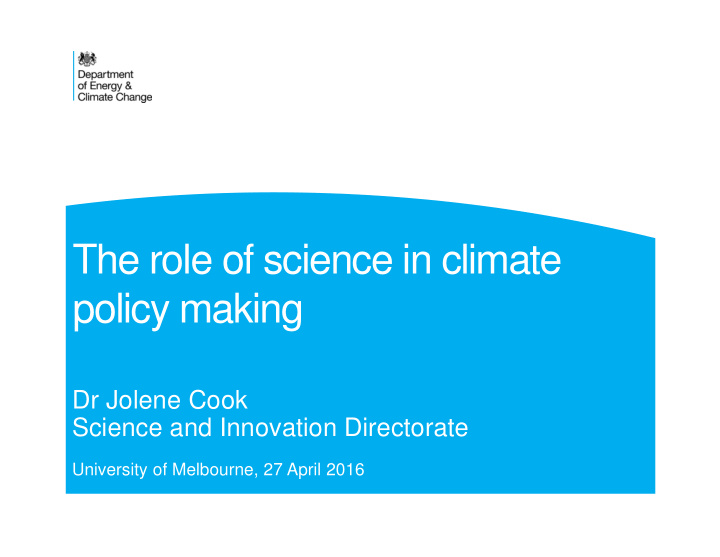



The role of science in climate policy making Dr Jolene Cook Science and Innovation Directorate University of Melbourne, 27 April 2016
In today’s talk… • Life at the science-policy interface: The path from post-doc to policy • Gathering and using the evidence 1. Geoengineering 2. Greenhouse gas metrics 3. The long-term global temperature goal • The Paris Agreement: future evidence needs 2
Life at the science-policy interface
The DECC Science team • Scientific support to DECC policy teams • Provides scientific advice to inform UK, EU and international climate policy • UK focal point for IPCC • Commissions evidence and engage with the research community and research councils • International engagement and science diplomacy • Greenhouse gas inventory and statistics • Climate science capability including Met Office Hadley Centre 4
EU climate policy making: context 1400 1990 Source: Eurostat 1200 2013 Total GHG 1000 emissions in 800 (Mt CO 2 e) 600 400 200 0 120 Source: World Bank 100 80 GDP per capita in 2014 60 (PPP) 40 ($ x 1000) 20 0 5
The importance of the IPCC • An assessment of the current literature • Policy relevant, not policy prescriptive • 195 parties signed up to the findings 6
Gathering and using evidence
Example 1: A new and controversial area
Geoengineering 9
Geoengineering: considerations Technical Technical Efficacy Efficacy Costs Costs Side effects Side effects feasibility feasibility Social Social Legality Legality Ethics Ethics Reversibility Reversibility acceptability acceptability 10
Forming policy on research Royal Society Government DECC Parliamentary report statement on analysis inquiry research (2009) Government response Cross-Government working group 11
Example 2: Combining science with value judgements
A basket of gases 13
Choice of metric and time horizon GWP100 GWP20 GTP100 SAR AR5 AR5 AR5 CO 2 1 1 1 1 CH 4 21 28 84 4 N 2 O 310 265 264 234 HFC23 11,700 12,400 12,700 SF 6 23,900 23,500 28,200 N NF 3 - 16,100 18,100 Other HFCs 140 – 9,200 1-8,060 19 – 12,700 14
The impact of choice of metric 12 High F gases 160% ↑ ↑ ↑ 193% ↑ ↑ ↑ ↑ ↑ Larger increase N 2 O 10 CH 4 CO 2 e emissions per year CO 2 Smaller increase 8 8.5% ↑ ↑ ↑ 7.8 % ↑ ↑ ↑ ↑ ↑ Smaller decrease ILLUSTRATIVE ONLY 8.2% ↓ ↓ ↓ ↓ 7.2% ↓ ↓ ↓ ↓ 6 4 Stronger decrease 7.9% ↓ ↓ ↓ ↓ 16% ↓ ↓ ↓ ↓ 2 0 1990 2008 1990 2008 1990 2008 1990 2008 1990 2008 1990 2008 1990 2008 1990 2008 GWP GTP GWP GTP GWP GTP GWP GTP China USA EU27 Brazil 15
Example 3: Science in the Paris Agreement
The Paris Agreement: an overview • A historic step forward : almost 200 countries committing to climate change action to which they will be held to account • National commitments : not yet on a cost-effective 2° C trajectory but a major deviation from business as usual • A framework for revisiting and raising ambition in the future • A long-term goal of net zero emissions in the second half of the century 17
The long-term goal in the Paris Agreement “… aims to … [hold] the increase in the global average temperature to well below 2 ° C above pre-industrial levels and to pursue efforts to limit the temperature increase to 1.5 ° C… ” (Article 2) “… to undertake rapid reductions … to achieve a balance between anthropogenic emissions by sources and removal by sinks of greenhouse gases in the second half of this century …” (Article 4) 18
The long-term temperature goal: A potted political history 1996: EU Environment Council conclusions 2009: UNFCCC Copenhagen Accord 2015: two-year review finishes; UNFCCC SBSTA conclusion 2010: UNFCCC Cancun Agreement 2015: Paris Agreement 2013: Start of a 2-year review of the long-term global temperature goal 2018: IPCC Special Report on 1.5 ° C 19
The Paris Agreement and the long- term goal: Future evidence needs
Impacts at 1.5/2/2.5 ° C From IPCC AR5 WGII 21
Actions and targets IPCC AR5 WGIII, Summary for Policymakers 22
Feasibility, challenges and risks 23
Regional/country implications of 1.5° C 24
Final remarks
The big picture Interdisciplinary collaboration Good communication! 26
Recommend
More recommend